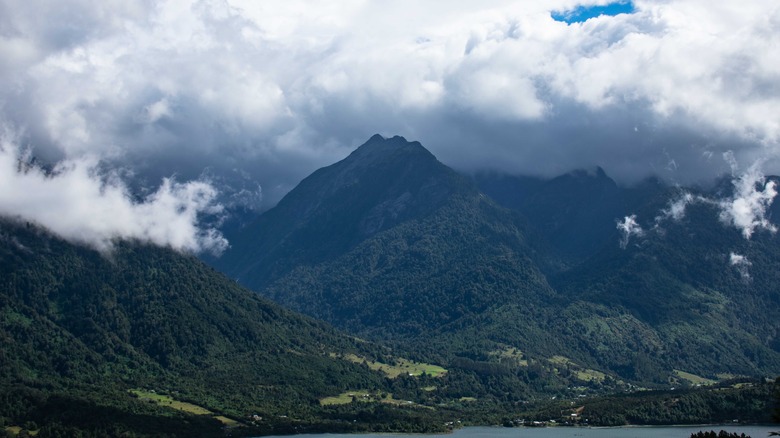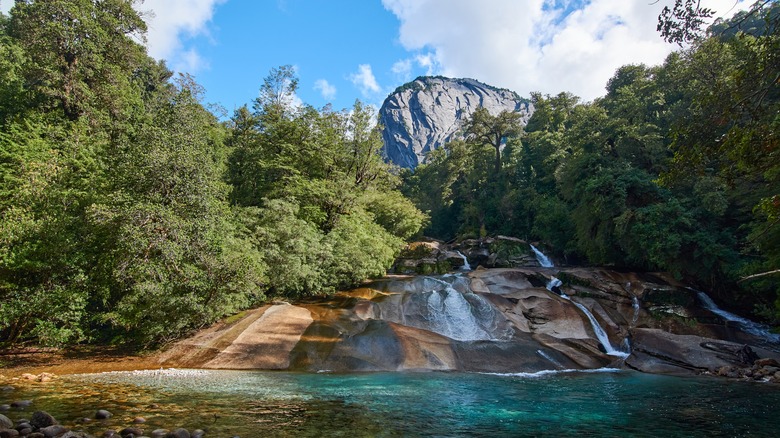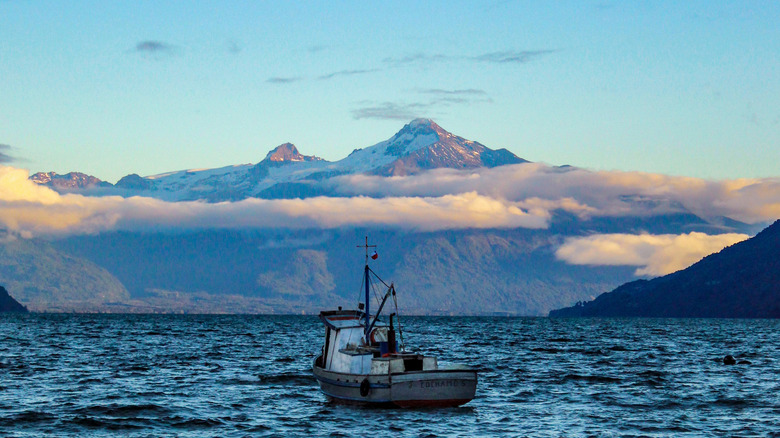One Of Chile's Most Underrated Valleys Is Known As South America's 'Yosemite'
In the Lakes Region of Chile sits Cochamó Valley, often referred to as "the Yosemite of Chile" thanks to a comparison popularized in 1997 by Seattle Times reporter Bill Dietrich. While many travelers tend to visit more well-known Chilean sites like Easter Island, global interest in Cochamó is steadily growing.
Like Yosemite, Cochamó Valley features tall granite walls and peaks that create a U-shaped valley carved out by glaciers over millions of years, spanning 28,170 acres of wetlands, glaciers, and forests. Lining these rocky precipices are lush and verdant trees that give way to one of the world's few temperate rainforests, making the area ecologically significant. In fact, the Cochamó District is home to a fifth of the world's remaining alerce forests. In addition to boasting ancient flora, the area is also home to a diverse array of rare and endangered animal species, including pudu (the world's smallest deer), Darwin's Frog, and nesting condors.
The increasing popularity of Cochamó Valley means more hikers and climbers are visiting each year from around the world to explore this relatively unknown paradise. The Cochamó Trail in particular draws tourists and has done for over 100 years; throughout history, the way has been traversed by gauchos, missionaries, and even outlaws like Butch Cassidy and the Sundance Kid. Due to a steady increase in the number of visitors, various conservation efforts have been put in place to protect the area's ecosystem and cultural heritage. If you're planning a trip to Cochamó Valley, consider visiting between September and April as this time of the year offers the best conditions for exploring the diverse landscape.
The flora and fauna of Cochamó Valley
The valley's temperate rainforest is, as you might expect, home to a huge variety of flora and fauna. Amongst its dense vegetation are the Alerce trees, which can live for thousands of years. Intertwined with the trees are ferns, vines, and the distinctive, bright-pink copihue flower – the national flower of Chile. In 2023, the Cohamó Valley Nature Sanctuary was established, protecting this area of mature forest and thousand-year-old larches, coniferous trees that are categorized as endangered by the IUCN. They also protect over 50 species of fauna, including the Andean condor.
Thanks to the area's well-preserved forests and rugged landscape, it is a crucial climate refuge that provides important ecosystem protection. Its skies are home to various migratory birds, including ibises, hummingbirds, and swallows, its waters teeming with amphibians, fish, and even marine life like dolphins, sea lions, and pelicans call its fjord home. The topography also hides various mammals, including wild boar, monito del monde (a species of small marsupial), and even pumas in the upper reaches.
The recent designation of the area as a nature sanctuary is a significant step towards preserving the valley's ecological importance while also balancing it with sustainable tourism and traditional practices. These ongoing efforts have helped the area's unique biodiversity to thrive.
Balancing conservation and adventure in Cochamó
Balancing conservation and adventure is a complex challenge that local communities, environmental organizations, and outdoors enthusiasts are working to address. Adventure tourism is a growing industry in the Cochamó Valley, with rock climbing, hiking, and other unique experiences drawing more visitors every year. Because the valley offers impressive granite walls and hiking routes through varied terrain while promising a "Yosemite with no roads," all of which serve to draw global attention to the area, local organizations are working to promote ecotourism as the main economy while regulating activities in order to protect the environment. With this growing popularity comes an increasing need to balance the recreational desires of thousands of annual visitors with environmental protection, and so many community-led initiatives, like Organización del Valle de Cochamó and Puelo Patagonia, have been actively working to promote sustainable tourism and protect the area from large-scale projects.
The ideal next step for the nature sanctuary is to develop a participatory governance model and management plan to balance tourism with ecological and cultural preservation and to establish trail maintenance, sanitation, and visitor management. Because Cochamó offers such a diverse range of adventure activities in a pristine natural setting but isn't a national park like nearby Villarica National Park, there is a careful balancing act between conservation and adventure. Luckily, it's one that local communities are working hard to establish.
If you choose to visit this "Yosemite of South America," be sure to expect a range of activities and landscapes. While Cochamó Valley offers unique hiking experiences, adventure seekers might also want to try some of the hikes in neighboring Peru. And for those interested in experiencing more of the country's natural wonders, why not explore some of the stunning beaches in South America?


